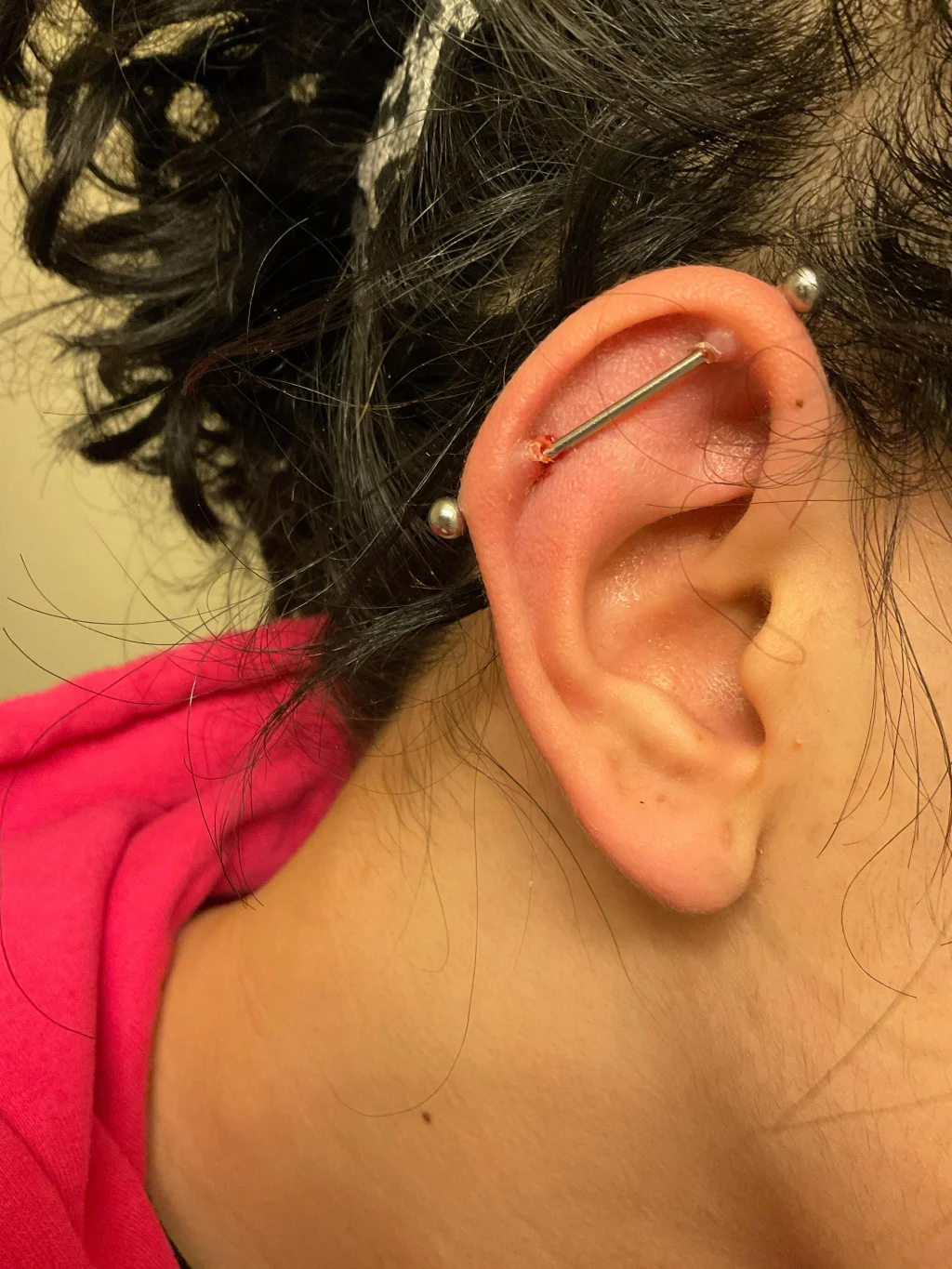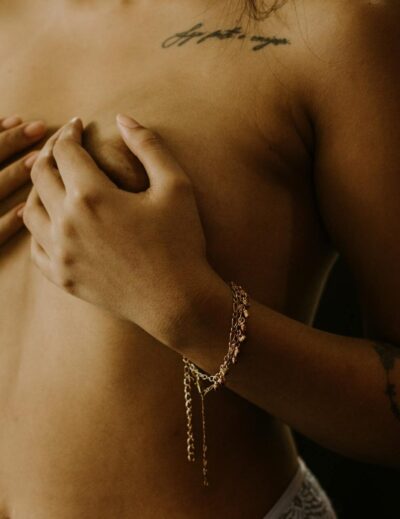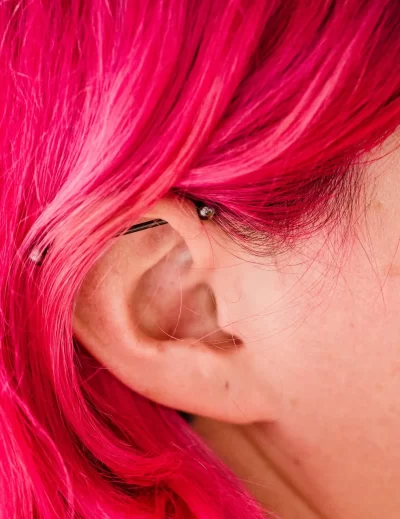Industrial Piercing Infection: What Does It Look Like and How to Treat?
Industrial piercings — two holes that share one barbell — look incredible, but only if they are healthy. Infected piercings are unattractive, and they feel awful too. As you begin your industrial piercing journey, make sure you know how to prevent and treat infections.
Industrial Piercing Infection Rate
What is the risk of infection when getting an industrial piercing? There’s a higher risk of infection with industrial piercings than with many other piercing styles. For one thing, industrial piercings involve two separate holes. Either one could develop an infection.
Also, industrial piercings are in the cartilage of the upper ear. Piercings in that region may get infected more often than others because they are near your hair. That increases the site’s exposure to oil, hair products, and other foreign items. Plus, your hair could get caught on the jewelry, which can irritate the piercing.
About 30% of piercings in the cartilage of the ear become infected, and many of those are industrial piercings. Considering the industrial piercing infection rate, you’ll want to make sure you’re being quite careful with this type of piercing.

What Does an Infected Industrial Piercing Look Like?
If your piercing site seems different from normal, you may be wondering, “What does an infected industrial piercing look like?” The following symptoms are commonly associated with piercing infections.
- Blood or pus
- Elevated body temperature
- Noticeable warmth at the site
- Pain
- Redness around the hole
- Significant swelling or a bump
Minor irritation is normal in the first few weeks after getting a new piercing, but if the symptoms worsen or develop later, you may be dealing with an infection.
What Causes Industrial Piercing Infections?
Typically, piercings become infected when bacteria get into the site. The bacteria could be delivered by unsanitary piercing tools, dirty hands, or other foreign items. Not being diligent about cleaning the piercing can also allow bacteria to take hold.
Trauma to the site can be another contributing factor to infections. This can happen when you twist, bump, snag, or otherwise jostle your jewelry as the site is healing.
If an Industrial Piercing Gets Infected Can It Kill You?
Not really. It is possible for an untreated infection to lead to sepsis, which can be fatal. But most piercing infections resolve without major complications. However,
That being said, an infection in your piercing can be an unpleasant experience that involves pain, swelling, and discharge. It may lead to scarring, and you might lose the piercing. Plus, a piercing infection can potentially spread and cause more serious issues like cellulitis or an abscess.
How to Treat an Infected Industrial Piercing
If an infection develops, you’ll want to make every effort to promote healing.
1. Clean With a Saline Solution
You should clean an infection site with salt water, also known as saline. You can use a store-bought product or mix 1 tsp of sea salt with 1 c of warm water. Using a cloth or a paper towel, wipe the solution over your skin and the jewelry.
Considering that your piercing is already infected, you can also use antiseptic solutions, such as betadine, isopropyl alcohol, or diluted hydrogen peroxide.
2. Warm Compress
A warm compress can promote healing, and it will feel nice too. You can use a sock filled with rice or a damp washcloth. Warm it in the microwave for a few seconds before placing it against the infection site.
3. Stay Away from Ointments
Antibiotic ointments and infected piercings aren’t a good combination. The thickness of the ointment may, unfortunately, hold the bacteria in the area. A dab of tea tree oil mixed with a carrier oil could be a better option.
4. Visit Your Piercer
Your piercing professional has experience with infected sites. If your symptoms don’t get better after a few days of care, it’s time to see the pros for treatment advice.
If My Industrial Piercing Is Infected Should I Take It Out?
It’s not generally recommended to remove the jewelry from an infected piercing. The holes could close and seal the bacteria underneath your skin. Consult a professional piercer or a doctor before taking out the barbell.
How to Clean an Infected Industrial Piercing
Saline is the best cleaning solution for a piercing. Pair it with a study rag or paper towel that won’t fall apart as you work.
- Dip the cloth in the solution. You can use a store-bought product or mix 1 tsp of sea salt with 1 c of warm water. Using a cloth or a paper towel, wipe the solution over your skin and the jewelry.
- Wipe the skin around the front and back of both holes.
- Wipe the jewelry where it enters and exits each hole as well as the balls on the end of the bar.
- Repeat until all flaking and discharge have been removed.
Be gentle as you clean so that you don’t further irritate the site.
How Long Does a Nipple Piercing Infection Take To Heal?
Generally speaking, it takes from a few days to 2 weeks to get rid of an industrial infection.
How to Prevent Industrial Piercing Infection?
While there’s no surefire way to prevent a piercing infection, the following tips can reduce your risk.
1. Wash Your Hands
Contaminated hands are likely to introduce bacteria to your healing wound. Always wash your hands thoroughly before doing any work with your piercing.
2. Avoid Unnecessary Contact
While touching your piercing to clean it is acceptable, you shouldn’t touch it absentmindedly or play with the jewelry. Also, be careful about letting anything snag or bump the piercing site.
3. Use Safe Metals

Industrial bar piercing cute with CZ stones gold and silver titanium 14G $19.9, SHOP NOW.
Jewelry that contains nickel can cause irritation, and soft gold may have tiny divots that harbor bacteria. Implant-grade titanium is one of the safest piercing metals to use. Implant-grade titanium is hypoallergenic and much less likely to cause infection.
Implant-grade stainless steel and 14-karat gold are other suitable options.
4. Leave the Jewelry In
Your piercing should be fully healed before you swap out the jewelry. It commonly takes a minimum of 6 to 9 months for healing. Changing the jewelry too soon often causes infections.
To Conclude
Industrial piercings require extra care during the healing process so that they don’t become infected. However, if you’re attentive to your cleaning routine and watchful for the signs of an infection, you should have an attractive, healthy piercing within a few months.





